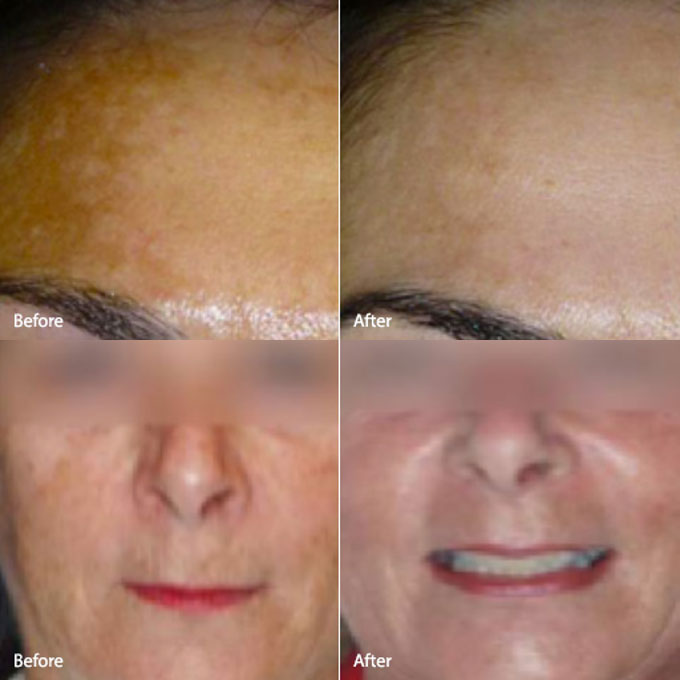Skin or face pigmentation? Laser peel treatment (skin resurfacing) uses targeted beams of light to reduce hyperpigmentation. We have the latest technology of Nd-Yag lasers- delivering energy at PICO-seconds. This is highly effective yet safe for skin of colour.
Melasma is a common skin problem. It causes brown to gray-brown patches on the face. Most people get it on their cheeks, bridge of their nose, forehead, chin, and above their upper lip. It also can appear on other parts of the body that get lots of sun, such as the forearms and neck.
Sun exposure triggers melasma.
One of the most common treatments for melasma is sun protection. This means wearing sunscreen every day and reapplying the sunscreen every 2 hours. Dermatologists also recommend wearing a wide-brimmed hat when you are outside. Sunscreen alone may not give you the protection you need.
Women are far more likely than men to get melasma. It is so common during pregnancy that some people call it the mask of pregnancy. Hormones seem to trigger melasma.
How do we at HEMAC aesthetic treat melasma?
Melasma can fade on its own. This often happens when a trigger is causing the melasma, such as a pregnancy or birth control pills. When the woman delivers the baby or stops taking the birth control pills, melasma can fade.
Some people, however, have melasma for years — or even a lifetime. If the melasma does not go away or a woman wants to keep taking birth control pills, melasma treatments are available which includes :
- Hydroquinone: This medicine is a common first treatment for melasma. It is applied to the skin and works by lightening the skin. You will find hydroquinone in medicine that comes as a cream, lotion, gel, or liquid.
- Tretinoin and corticosteroids: To enhance skin lightening and efficacy of hydroquinone, a combination therapy with 3 medicines medicines (hydroquinone, tretinoin, and a corticosteroid) in 1 cream can be very effective.
- Other topical (applied to the skin) medicines: azelaic acid or kojic acid can also help lighten melasma.
- Procedures: If a topical medicine does not get rid of your melasma, a procedure may succeed. Procedures for melasma include a series of chemical peels (such as glycolic acid), microdermabrasions and laser treatments- Pastelle/Nd-Yag or Intense Pulse light (IPL).
Some newer treatment includes :
- Cyklokapron and vitamin C tablets which helps to reduce the synthesis of pigmentations associated with hormones.
- Crystal Tomato super- antioxidant vitamin contains L-Cysteine which inhibits the production of melanin whilst boosting one’s general health.
(Both of these are sometimes incorporated into our treatments for resistant melasma.)
Outcome
Many people with melasma have a good outcome but melasma can be stubborn. It may take a few months of treatment to see improvement. It is imperative to follow your post treatment care. This ensures that you get the most benefit from treatment. It also can help avoid skin irritation and other side effects.
After your melasma clears, it is important that you continue on a maintenance therapy so as to prevent recurrence of the condition which includes a lightening skincare and proper usage of sunscreen and sun protection. Below are some tips to achieving more even skin tone :
Wear sunscreen daily: One of the most common treatments for melasma is sun protection. Since sunlight triggers melasma, it is important to wear sunscreen every day, even on cloudy days and after swimming or sweating. Choose a sunscreen that offers broad-spectrum protection, a Sun Protection Factor (SPF) of 30 or more, and zinc oxide and/or titanium dioxide to physically limit the effects of the sun’s rays on your skin. Apply sunscreen 15 minutes before going outside and reapply at least every two hours.
- Wear a wide-brimmed hat when you’re outside: As a recent study in the journal Nature illustrates, sunscreen alone may not give you the sun protection you need. Whenever possible, seek shade and wear protective clothing in addition to applying sunscreen.
- Choose gentle skin care products: Choose skin care products that don’t sting or burn, as products that irritate the skin may worsen melasma.
Avoid waxing: Waxing may cause skin inflammation which can worsen melasma, so it’s important to avoid waxing areas of the body affected by the condition. AT HEMAC, we recommend laser hair removal. If your melasma does not go away, see a board-certified dermatologist to discuss available treatments for melasma, such as prescription medications or in-office procedures.

